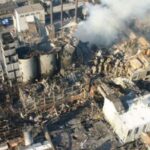A 3-Phase Strategy for Controlling Combustible Dusts Hazards

Dusts are a workplace nuisance but not a serious hazard. At least that’s what some of your workers may believe. But dating back to the deadly mine explosions of centuries ago, dust fires and explosions have killed thousands of Canadian workers across the span of history. And the nation’s most horrifying workplace tragedy of recent times, the Nova Scotia Westray mine explosion, was due to the ignition of combustible dusts and gases.
The Hazard
It takes 4 elements to create a dust fire or explosion:
- Combustible dust: The dust particles must come from combustible materials, such as wood, coal, rubber, grain, sugar, flour, cotton, cardboard, aluminum and other solid substances commonly found at metal processing, wood and plastic products, sugar refineries, food and pharmaceutical production, grain storage, cotton and rubber fabrication facilities;
- Dispersion: The dust cloud must be widely dispersed and have a concentration above what’s called the lower explosive limit (LEL) at which it’s capable of producing a flash of fire if it’s ignited; and
- Oxygen: The area in which the dust particles are present must contain oxygen; and
- Ignition: The explosive dust cloud must be exposed to a source of ignition such as sparks, static electricity and friction, open flames and hot surfaces.
If these 4 elements are present, the ignition of the combustible dust will cause what’s called ‘deflagration,’ or rapid combustion. And if deflagration takes place in an area that’s enclosed, like a building, room or vessel, it may release pressure high enough to produce an explosion.
What the Law Requires
The OHS laws require employers to take basic measures to prevent these 4 deadly elements from converging.
Phase 1. Combustible Dust Hazard Assessment
First, you need to perform a hazard assessment to determine whether there are combustible dusts hazards at your site that considers all the materials that are handled, all the operations conducted (including any byproducts they create) and all spaces located in the workplace. To carry out the actual assessment, designate a competent person to:
- Gather dust samples from equipment, floors and surfaces;
- Determine if those samples are combustible, if necessary, by performing lab tests;
- If dusts are combustible, calculate whether they’re found in concentrations at or above the LEL, which varies depending on the particular substance(s) that comprise the dust; and
- Determine if combustible dusts at or above the LEL are exposed to any sources of ignition.
Phase 2. Selection of Combustible Dust Controls
The next challenge is to implement appropriate policies and controls to eliminate or minimize the combustible dusts hazards you identify in your hazard assessment. As with most hazards, follow the hierarchy of control approach.
Substitution
If reasonably practicable, eliminate the hazard by getting rid of materials that generate combustible dusts and substituting safer alternatives. Unfortunately, while substitution is the best possible solution, it’s rarely a viable option, especially for metal processing, pharmaceuticals, textiles, woodworking, pulp and paper, fracking and other industries and operations for which combustible dust in an inherent problem that can’t be avoided.
Engineering Controls
If substitution isn’t reasonably practicable, you must use a combination of engineering and work/administrative controls to manage combustible dust hazards. The name of the game: Don’t let dangerous dust accumulations come together with ignition sources. Engineering controls typically include:
- Physically segregating combustible dust operations from other work areas;
- Using mechanical systems, equipment and devices to prevent or reduce dangerous dust emissions;
- Using filters and separator devices to remove foreign materials capable of igniting combustibles from process materials;
- Using work surfaces made of materials that don’t collect dust;
- Using tools or equipment that don’t generate sparks or heat;
- Bonding equipment to the ground and taking other steps to ensure that electrical systems, equipment and wiring don’t emit sparks or static electricity;
- Using only vacuum cleaners approved for dust collection; and
- Locating relief valves away from dust deposits.
Administrative & Work Controls
Work or administrative controls minimize hazards by ensuring the work is carried out as safely as possible. Work controls for combustible dusts typically include:
- Banning hot work, powered mobile equipment and other operations involving the use of equipment or processes likely to constitute sources of ignition from work areas where combustible dusts at dangerous concentrations are or may be present;
- Banning smoking in all work areas containing combustible dusts;
- Implementing good housekeeping, inspection and cleanup practices to prevent dangerous dust buildup;
- Developing safe work procedures for operations involving exposure to combustible dusts;
- Implementing emergency action and fire response plans in case dust fires and explosions do occur;
- Providing preventive maintenance of equipment; and
- Ensuring workers receive the necessary safety information and training to implement safe work procedures and protect themselves from combustible dust hazards.
Phase 3. Monitoring of Combustible Dust Controls
You need to continually monitor your current combustible dusts controls, determine if they’re effective and make any necessary corrections. Regular monitoring should take place at least once a year. Monitoring should also be done:
- In the course of regular JHSC inspections of work areas identified as containing combustible dusts;
- As part of incident investigations done after fires, explosions, and other combustible dust events (or potential combustible dust events); and
- In response to changes in the conditions on which your current hazard assessment is based, e.g., the introduction of new equipment or work processes.